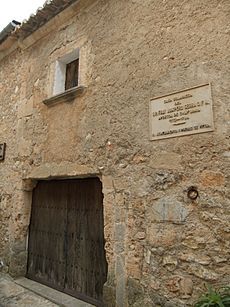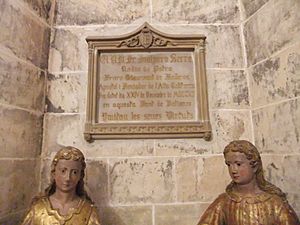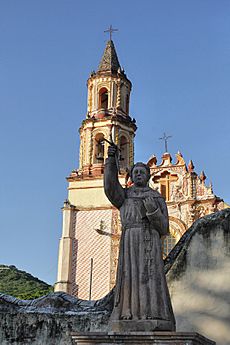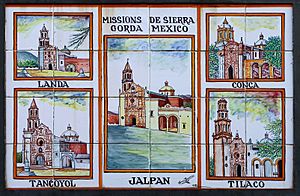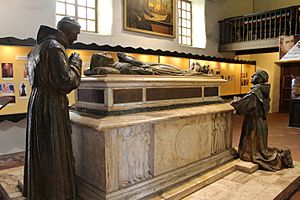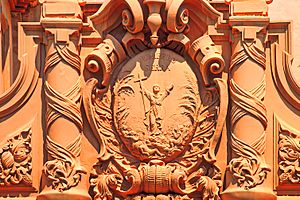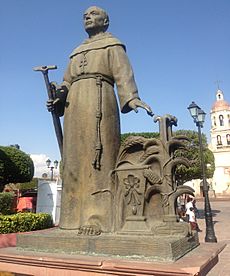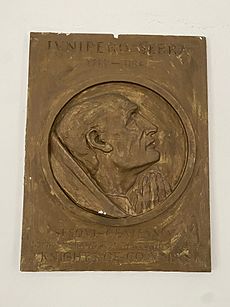Junipero Serra facts for kids
Quick facts for kids SaintJunípero Serra O.F.M. |
|
|---|---|
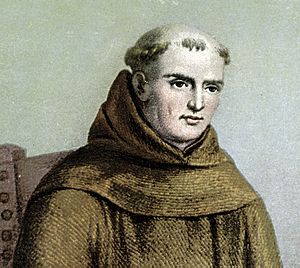
A portrait of Serra
|
|
| Apostle of California | |
| Born | Miquel Josep Serra i Ferrer November 24, 1713 Petra, Majorca, Crown of Aragon |
| Died | August 28, 1784 (aged 70) Mission San Carlos Borromeo de Carmelo, Las Californias, New Spain, Spanish Empire |
| Beatified | September 25, 1988, Saint Peter's Square, Vatican City by Pope John Paul II |
| Canonized | September 23, 2015, Basilica of the National Shrine of the Immaculate Conception by Pope Francis |
| Major shrine | Mission San Carlos Borromeo de Carmelo, Carmel-by-the-Sea, California, United States |
| Feast | August 28; July 1 in United States |
| Attributes | Franciscan habit, wearing a large crucifix, or holding a crucifix accompanied by a young Native American boy |
| Patronage |
|
Saint Junípero Serra (born Miquel Josep Serra i Ferrer; November 24, 1713 – August 28, 1784) was a Spanish Catholic priest. He was a Franciscan missionary. He is famous for starting many missions in what is now California.
Serra helped create a group of missions in Mexico called the Franciscan Missions in the Sierra Gorda of Querétaro. These are now a UNESCO World Heritage Site. Later, he founded a mission in Baja California. He also started eight of the 21 Spanish missions in Alta California. These missions stretched from San Diego to San Francisco.
In 1988, Pope John Paul II declared Serra a "Blessed" person (a step towards sainthood). In 2015, Pope Francis made him a saint. This happened during the Pope's first visit to the United States. Serra is sometimes called the "Apostle of California" because of his work.
However, some people have criticized Serra's work. Native American groups say that people were forced to convert to Catholicism. They also say that Native Americans were mistreated at the missions.
Contents
Early Life and Education
Junípero Serra was born Miquel Josep Serra i Ferrer. He was born in a village called Petra. This village is on the island of Mallorca in Spain. His parents were Antonio Nadal Serra and Margarita Rosa Ferrer.
From a young age, Miquel worked in the fields with his parents. He helped grow crops like wheat and beans. He also took care of cattle. But he was very interested in the local Franciscan church. He went to the friars' school there. He learned to read, write, and do math. He also studied Latin, religion, and church music. He had a good singing voice.
When he was 16, Miquel's parents sent him to a Franciscan school in Palma. There, he studied philosophy. A year later, he decided to join the Franciscan order. This meant he would become a friar.
Joining the Franciscans
On September 14, 1730, just before his 17th birthday, Miquel joined the Franciscan Order. He became a novice, which is a period of strict training. He was given the new name Junípero. This name honored Brother Juniper, an early companion of Francis of Assisi.
As a novice, Junípero promised to live simply and not marry. He spent seven years studying to become a Catholic priest. He studied logic, science, and theology very deeply. His daily life was very strict. It included prayers, meditation, singing, and chores. Friars even woke up at midnight to sing.
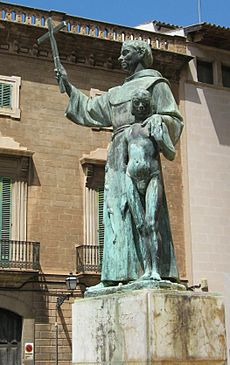
In 1737, Serra became a priest. Three years later, he started teaching philosophy at a church school. He taught over 60 students, including future missionaries Francisco Palóu and Juan Crespí. Serra was known for being very smart. He earned a special degree in theology. He also taught philosophy at a college in Palma.
During his last five years on Mallorca, his home village faced hard times. There was a drought and a plague. Serra would visit his parents and help them financially. He even gave his sick father the last rites.
In 1748, Serra and Palóu decided they wanted to be missionaries. Serra was 35 and could have had an important career in Mallorca. But he wanted to go to new lands. They asked the Spanish government for permission to go on a mission abroad. After some delays, they got approval. They sailed to Cádiz, a port in Spain.
Before leaving, Serra wrote a letter to a friend. He asked his friend to comfort his elderly parents. Serra's parents could not read, so the friend read the letter to them. Serra wrote that God would turn their sadness into happiness. He wanted them to prepare for a good death.
Missionary Work in New Spain
In 1749, Serra and other Franciscan missionaries arrived in Veracruz, Mexico. This was part of New Spain at the time. To get to Mexico City, they had to travel a long, difficult road. Spanish officials offered horses to the friars. But Serra and another friar chose to walk. They followed the rule of Francis of Assisi that friars should not ride horses unless necessary.
They walked without money or a guide, carrying only their prayer books. They trusted that people along the way would help them. During the walk, Serra's left foot swelled up and itched badly. He thought it was a mosquito bite. He scratched it so much that his leg became raw and bleeding. This wound bothered him for the rest of his life.
Serra believed his main goal was to convert Native Americans to the Catholic faith. He thought that if someone died without being baptized, it was a tragedy. But if a baptized person died, it was a joyful event.
Here are some of the missions Serra founded in California:
- Mission San Diego de Alcalá, July 16, 1769, in San Diego.
- Mission San Carlos Borromeo de Carmelo, June 3, 1770, in Carmel-by-the-Sea.
- Mission San Antonio de Padua, July 14, 1771.
- Mission San Gabriel Arcángel, September 8, 1771, in San Gabriel.
- Mission San Luis Obispo de Tolosa, September 1, 1772, in San Luis Obispo.
- Mission San Juan Capistrano, November 1, 1776, in San Juan Capistrano.
- Mission San Francisco de Asís, June 29, 1776, in San Francisco.
- Mission Santa Clara de Asís, January 12, 1777, in Santa Clara.
- Mission San Buenaventura, March 31, 1782, in Ventura.
The missions had several goals. Their main purpose was to teach Native Americans about the Catholic faith. They also aimed to organize Native Americans into a workforce. This workforce would support Spanish power in the new lands. The missions also trained Native Americans to manage the land.
Native Americans who converted to Christianity were kept separate from those who had not. This was to prevent them from returning to their old ways. Discipline was strict. Converts were not allowed to leave the mission freely. Those who were baptized had to live at the mission. They were also required to work as farmers, shepherds, or craftsmen. Many Native Americans suffered from disease, hunger, and overwork at the missions.
The missions also served economic and political purposes. They produced all the colony's cattle and grain. By the 1780s, they even had extra goods to trade with Mexico.
In 1779, Franciscan missionaries led by Serra planted California's first lasting vineyard. Because of this, Serra is sometimes called the "Father of California Wine". The type of grape he planted became known as the Mission grape. It was the main grape for California wine until about 1880.
Death and Legacy
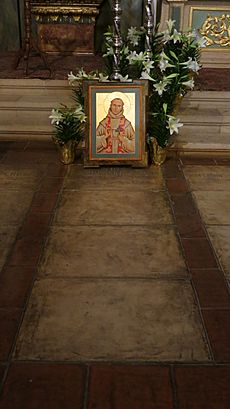
In the last three years of his life, Serra visited the missions again. He traveled over 600 miles from San Diego to San Francisco. He confirmed over 5,300 people who had been baptized. He suffered greatly from his leg injury and chest pain. But he refused to use any medicine.
On August 28, 1784, Junípero Serra died at the age of 70. He died at Mission San Carlos Borromeo from tuberculosis. He is buried there under the church's altar. After Serra's death, Fermín Lasuén took over leading the Franciscan missions in California.
Becoming a Saint
The process to make Serra a saint began in 1951. He was declared "Blessed" by Pope John Paul II on September 25, 1988. The Pope said Serra "sowed the seeds of Christian faith" in the New World. He noted that this work required patience, courage, and humility.
During the process, questions were raised about how Native Americans were treated at the missions. Historians provided information about this.
Serra was made a saint by Pope Francis on September 23, 2015. This was the first time a saint was canonized on American soil. Pope Francis called Serra "one of the founding fathers of the United States." He also called him a special patron of Hispanic people in the country.
Serra's feast day is celebrated on July 1 in the United States. Everywhere else, it is celebrated on August 28. He is considered the patron saint of California, Hispanic Americans, and religious callings.
Serra's grave at the Mission in Carmel, California, is still a place people visit. His burial spot is marked on the floor. There are also pieces of his coffin and personal items on display. A large sarcophagus was made for him in 1924, but his remains were never moved into it.
Serra's Impact and Recognition
Many of Serra's letters and writings still exist today. The Santa Barbara Mission Archive-Library holds many of his early documents. This library is part of the Mission Santa Barbara complex.
The chapel at Mission San Juan Capistrano was built in 1782. It is thought to be the oldest standing building in California. It is often called "Father Serra's Church." Serra is known to have held Catholic services there.
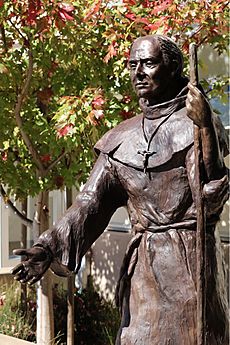
Many places in California are named after Serra. These include streets, schools, and neighborhoods. For example, there is Junipero Serra Boulevard in San Francisco. There is also Serramonte, a neighborhood near San Francisco. Junipero Serra Peak is the highest mountain in the Santa Lucia Mountains.
Both Spain and the United States have honored Serra with postage stamps. In 1884, California made August 29 a holiday. This was to mark 100 years since Serra's burial.
Serra International is a global organization that encourages people to become priests or nuns. It was named in Serra's honor. It was founded in 1935 and has about 20,000 members worldwide.
Serra's treatment of Native Americans has been a big topic of discussion. Some groups have protested his canonization. They believe his legacy includes violence against Native Americans. In 2019, Stanford University renamed two buildings that were named after Serra. This was because of the mission system's history of violence against Native Americans.
Statues and Monuments
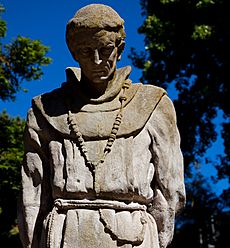
- A statue of Junípero Serra represents California in the National Statuary Hall Collection in the United States Capitol. It shows Serra holding a cross.
- A statue of Serra in Ventura, California, stood in front of Ventura City Hall for many years. In 2020, city, church, and tribal leaders agreed to move it off public land.
- The Douglas Tilden statue of Serra in Golden Gate Park in San Francisco was pulled down by protestors in June 2020.
- In 1899, Jane Elizabeth Lathrop Stanford paid for a granite monument to Serra in Monterey.
- Interstate 280 in California is named the Junipero Serra Freeway. A statue of Serra on a hill in Hillsborough, California, points towards the Santa Cruz Mountains.
- A bronze statue of Serra in the California State Capitol's Capitol Park was also pulled down by protestors in July 2020.
- A statue of Serra is in the courtyard of Mission Dolores in San Francisco.
- A life-size bronze statue of Serra was removed from Mission Plaza in San Luis Obispo in June 2020.
- Statues or other monuments to Father Serra are found at several other mission churches.
- A statue of Junipero Serra near the San Fernando Mission in Los Angeles was vandalized in 2017.
Images for kids
-
Serra founded the five Missions of the Sierra Gorda in Querétaro, Mexico between 1750–60. (Santa María del Agua de Landa pictured).
-
Plaque honoring Serra at Mission San Miguel Concá in Arroyo Seco, Querétaro.
-
Plaza de Junípero Serra in Petra, Mallorca, Spain.
-
Plaque at Serra's house in San Juan, Puerto Rico.
-
Gaspar de Portolá's appointment as Governor of the Californias in 1767 coincided with Serra's appointment as chief of the missions in the Californias.
-
Serra prepared his evangelizing mission of Alta California at Mission Loreto, in Baja California, in 1768–69.
-
The Junípero Serra Museum at the Presidio of San Diego, California.
-
Statue of Junipero Serra at Mission San Diego de Alcalá.
-
Illustration of Serra celebrating as the resupply ships the San Antonio and the San Carlos arrive at San Diego Bay on March 19, 1770.
-
Monument marking the landing place of Serra in Monterey, California.
-
The Vizcaíno-Serra Oak, in Monterey, where Sebastián Vizcaíno celebrated mass in 1602 and Serra celebrated mass in 1770.
-
Mission San Diego de Alcalá was founded by Serra in 1769, as the first of the California missions.
-
Mission San Carlos Borromeo del Río Caramelo, where Serra died, was founded in 1770.
-
Mission San Gabriel Arcángel, founded in 1771.
-
Mission San Juan Capistrano, founded in 1776.
-
Mission San Francisco de Asís, founded in 1776.
-
Statue of Junípero Serra by Ettore Cadorin is one of two statues representing California in the National Statuary Hall at the U.S. Capitol.
-
Serra's coffin at Mission San Carlos Borromeo de Carmelo.
See also
 In Spanish: Junípero Serra para niños
In Spanish: Junípero Serra para niños


